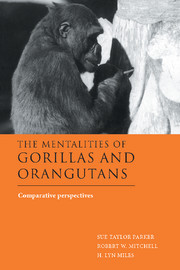Book contents
- Frontmatter
- Contents
- List of contributors
- Preface
- Acknowledgments
- I Comparative evolutionary and developmental perspectives on gorillas and orangutans
- II Cognition and tool use in gorillas and orangutans
- III Communication in gorillas and orangutans
- 10 Symbolic communication with and by great apes
- 11 The development of spontaneous gestural communication in a group of zoo-living lowland gorillas
- 12 Early sign-language acquisition: comparisons between children and gorillas
- 13 Early sign performance in a free-ranging,adult orangutan
- IV Social cognition in gorillas and orangutans
- V Epilogue
- Index of authors
- Index of subjects
12 - Early sign-language acquisition: comparisons between children and gorillas
Published online by Cambridge University Press: 20 October 2009
- Frontmatter
- Contents
- List of contributors
- Preface
- Acknowledgments
- I Comparative evolutionary and developmental perspectives on gorillas and orangutans
- II Cognition and tool use in gorillas and orangutans
- III Communication in gorillas and orangutans
- 10 Symbolic communication with and by great apes
- 11 The development of spontaneous gestural communication in a group of zoo-living lowland gorillas
- 12 Early sign-language acquisition: comparisons between children and gorillas
- 13 Early sign performance in a free-ranging,adult orangutan
- IV Social cognition in gorillas and orangutans
- V Epilogue
- Index of authors
- Index of subjects
Summary
In recent years, claims about the acquisition of sign language in chimpanzees, gorillas, and orangutans have been shrouded in controversy. On one side of this controversy have been researchers who have reported impressive language abilities in these species (Fouts, 1973; Gardner & Gardner, 1974; Patterson, 1978, 1980; Miles, 1983, 1990; Gardner, Gardner, & Van Cantfort, 1989; Patterson & Cohn, 1990). On the other side have been investigators who have dismissed these claims as largely unfounded (Seidenberg & Petitto, 1979; Sebeok & Umiker-Sebeok, 1980; Sebeok & Rosenthal, 1981; Terrace, 1985). Throughout this controversy, great effort often has been expended trying to answer the question “Do apes have language?” as if this question could be resolved unequivocally “yes” or “no.” A much more fruitful approach would be to devote greater effort determining more precisely the particular language and communicative capabilities of these species (Greenfield & Savage-Rumbaugh, 1990; Miles, 1990, 1997). An important early step in this approach to the issue of language in nonhuman primates would be to focus on how sign-language learning apes and humans both resemble and differ from each other (Rimpau, Gardner, & Gardner, 1989).
In most of the cross-species comparisons of language acquisition that have been conducted, the gestural or sign-language productions of apes were contrasted only with the spoken-language productions of young children. A major shortcoming with this approach is that it is not clear what conclusions can be drawn from such comparisons. Any differences that were observed could be attributed to differences between the species, to differences between the languages, or to both.
- Type
- Chapter
- Information
- The Mentalities of Gorillas and OrangutansComparative Perspectives, pp. 240 - 264Publisher: Cambridge University PressPrint publication year: 1999
- 1
- Cited by



